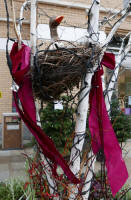The Church of the Holy and Undivided Trinity with Saint
Jude, Upper Chelsea, commonly called Holy Trinity Sloane Street or Holy
Trinity Sloane Square, is a Church of England parish church in London,
England.
Holy Trinity Sloane Square was dubbed the
Cathedral of the Arts and Crafts Movement by the Poet Laureate
Sir John Betjeman. It is one of the few churches in the British
Isles that can be regarded as what the Germans describe as a 'gesamtkunstwerk'
- a total work of art.
Behind its magnificent red brick and stone facade,
reminiscent of collegiate architecture of the late
16th and early 17th-century, is a veritable jewel-box
of stained glass, sculpture and highly wrought
metalwork by many of the finest artists and craftsmen
of the late nineteenth century. The 5th Earl Cadogan
and his wife Beatrix were responsible for the decision
to replace an earlier church building and, presumably,
for the choice of the architect, John Dando Sedding
(1838-1891). They couldn’t have chosen better.
Sedding had trained in the offices of G.E Street
(1824-1881), the most prolific and influential
ecclesiastical architect of the previous generation,
in whose offices William Morris, Philip Webb and
Norman Shaw had also trained. Sedding was one of the
prime movers of what became known as the Arts and
Crafts Movement, which drew much of its early
inspiration from the example and teachings Pugin and
Ruskin. At the 1888 Liverpool Art Congress Sedding, in
a veritable roll-call of the advanced architects and
designers of the day, declared ‘We should have had no
Morris, no Burges, no Shaw, no Webb, no Bodley, no
Rossetti, no Crane, but for Pugin.’
The first thing that impresses visitors to Holy
Trinity is the wealth of stained glass, particularly
the great east window designed by Burne-Jones, the
largest window Morris & Company ever made; equally
impressive are the windows by William Blake Richmond
and Christopher Whall in the North and South aisles
respectively. Not quite as showy, but just as
impressive, is the range of sculpture, particularly
F.W Pomeroy’s bronze angels on the chancel screen and
his sculptured reliefs above and on the choir stalls.
The work of other major sculptors from what became
known as the ‘New Sculpture’ movement are also well
represented – Onslow Ford, H.H Armstead, Harry Bates
and John Tweed, who carved the marble reredos – all
add to the richness of the interior, as does the
wealth of different marbles employed, especially on
the pulpit and in the Lady Chapel. Of almost equal
importance to Sedding in the designing of the interior
is his chief assistant, Henry Wilson (1864-1934), who
carried on and embellished the church after Sedding’s
untimely death two years after Lady Cadogan laid the
foundation stone. While the main structure is as
Sedding designed it the street railings and much of
the interior fittings and decoration – the font, the
Lady Chapel, the Byzantine-inspired metal screen and
the bronze angels that flank the entrance to the
Memorial Chapel – owe their inspiration, and in
several cases, their design, to Wilson. The south
chapel was remodelled by F.C. Eden in the wake of the
First War to become the Memorial Chapel with Eden’s
crucifix painted by Egerton Cooper, and the panelling
inscribed with the names of parishioners killed in
that and subsequent conflicts. The actual War Memorial
was erected in Sloane Square and on Remembrance Sunday
clergy, choir and congregation process from the church
to the Square to pay their tribute. One of the many
acts that ties Holy Trinity to the local community.
|

6 Geese a-laying |

Cyclamen |
On the twelfth day
of Christmas,
my true love gave to me
Twelve drummers drumming,
Eleven pipers piping,
Ten lords a-leaping,
Nine ladies dancing,
Eight maids a-milking,
Seven swans a-swimming,
Six geese a-laying,
Five golden rings,
Four calling birds,
Three French hens,
Two turtle doves,
And a partridge in a pear tree!
|
 |
 The Thin House
Originally, back in the
19th Century, 5
Thurloe Square was an artist’s studio. Nowadays, it’s a pricey piece of
property offering up a number of flats. Despite looking
impossibly narrow from the south-west corner of Thurloe Square, it’s
actually triangular, meaning it widens—albeit undramatically—from its
skinniest point. It’s definitely one of London’s coolest optical
illusions!
It is 6ft wide at its narrowest |